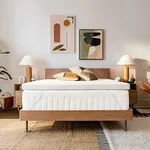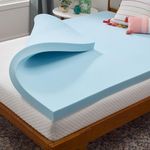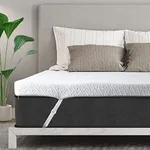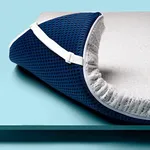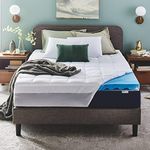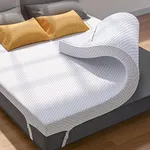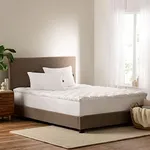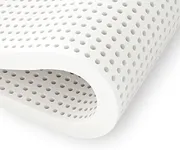Buying Guide for the Best Memory Foam Mattress Topper
Choosing the right memory foam mattress topper can significantly enhance your sleep quality by providing additional comfort and support. When selecting a mattress topper, it's important to consider several key specifications to ensure you find the best fit for your needs. Understanding these specifications will help you make an informed decision and improve your overall sleep experience.ThicknessThickness refers to the height of the mattress topper and is crucial for determining the level of support and comfort it provides. Thicker toppers (3-4 inches) offer more cushioning and are ideal for side sleepers or those with heavier body weights. Medium thickness (2-3 inches) is suitable for back sleepers or those who need moderate support. Thinner toppers (1-2 inches) are best for those who want to add a slight layer of comfort without significantly altering the feel of their mattress. Choose the thickness based on your sleeping position and the level of support you require.
DensityDensity measures the weight of the memory foam per cubic foot and affects the topper's durability and support. High-density foam (5 lbs/ft³ or more) offers better support and longevity, making it suitable for those with back pain or heavier individuals. Medium-density foam (3-5 lbs/ft³) provides a balance of comfort and support, ideal for most sleepers. Low-density foam (less than 3 lbs/ft³) is softer and more affordable but may not last as long. Consider your need for support and how long you want the topper to last when choosing the density.
FirmnessFirmness indicates how soft or hard the mattress topper feels. A softer topper is more comfortable for side sleepers as it allows for better contouring around the shoulders and hips. Medium firmness is generally preferred by back sleepers as it provides a balance of support and comfort. Firmer toppers are better for stomach sleepers or those who need extra support to maintain spinal alignment. Your preferred sleeping position and comfort preference should guide your choice of firmness.
Cooling FeaturesCooling features are designed to regulate temperature and prevent overheating during sleep. Memory foam can retain heat, so toppers with cooling gel infusions, breathable covers, or open-cell structures can help dissipate heat and keep you cool. If you tend to sleep hot or live in a warmer climate, look for toppers with these cooling technologies to ensure a comfortable night's sleep.
Motion IsolationMotion isolation refers to the topper's ability to absorb movement and prevent it from transferring across the bed. This is particularly important if you share your bed with a partner, as it can minimize disturbances from their movements. Memory foam naturally excels at motion isolation, but some toppers are specifically designed to enhance this feature. If you are a light sleeper or have a restless partner, prioritize toppers with good motion isolation.
Hypoallergenic PropertiesHypoallergenic properties indicate that the topper is resistant to allergens such as dust mites, mold, and bacteria. This is important for individuals with allergies or respiratory issues. Look for toppers made from hypoallergenic materials or those with antimicrobial treatments to ensure a healthier sleeping environment. If you are prone to allergies, this specification should be a priority.
Cover MaterialThe cover material of the mattress topper can affect its comfort, breathability, and ease of maintenance. Common materials include cotton, bamboo, and polyester blends. Cotton covers are soft and breathable, bamboo covers are eco-friendly and moisture-wicking, and polyester blends are durable and easy to clean. Consider your preferences for feel, breathability, and maintenance when choosing the cover material.
